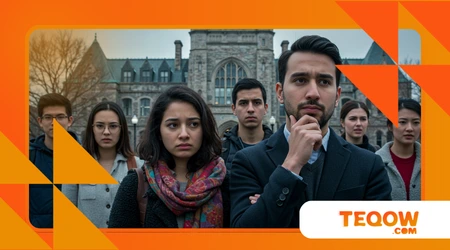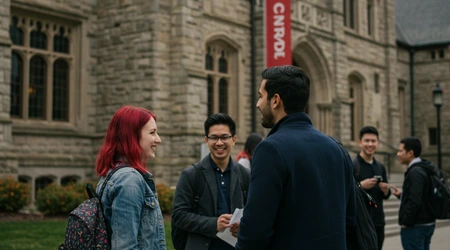New Rules for International Students: What’s Changing in 2025?

New rules for international students are reshaping Canada’s education landscape in 2025, sparking debates about accessibility, economic impact, and cultural diversity.
As a nation that has long welcomed global scholars, Canada is tightening its immigration policies to address housing shortages, healthcare pressures, and labor market dynamics.
These changes, announced by Immigration, Refugees and Citizenship Canada (IRCC), aim to balance economic stability with the benefits of international education.
But what do they mean for students dreaming of studying in Canada?
This article dives into the new rules for international students, exploring their implications with fresh insights, real-world examples, and a critical lens.
From visa caps to work permit restrictions, we’ll unpack the policies, their rationale, and their impact on students, institutions, and Canada’s global reputation.
International education is a cornerstone of Canada’s identity, contributing $22 billion annually to the economy and supporting over 200,000 jobs, according to Universities Canada (2023).
Yet, rapid growth in student numbers over 800,000 study permits issued in 2022 has strained public services.
The new rules for international students reflect a government response to these pressures, but they also raise questions about fairness and long-term consequences.
Are we closing doors on talent that could shape Canada’s future?
Let’s explore the changes, their motivations, and what students can do to navigate this shifting terrain.
Understanding the New Rules for International Students
Canada’s international student program is undergoing its most significant overhaul in decades. The new rules for international students cap study permits at 360,000 for 2025, a 10% reduction from 2024.
This follows a 35% cut in 2024, signaling a deliberate slowdown. The IRCC cites housing shortages and healthcare strain as key drivers.
Cities like Toronto and Vancouver, where rental vacancies hover below 1%, face intense pressure from population growth.
Beyond caps, the new rules for international students raise financial requirements. Proof of funds has jumped from $10,000 to $20,635, ensuring students can afford Canada’s rising costs.
This aims to reduce reliance on part-time work, but critics argue it excludes capable students from lower-income countries.
For example, Priya, an aspiring nurse from India, saved for years to study in Ontario. The new financial threshold now feels like a locked gate, despite her academic excellence.
Another change targets spousal work permits. Previously, spouses of students could access open work permits, easing financial burdens.
Now, only those married to graduate students in high-demand fields like medicine or engineering qualify.
This shift, effective September 2024, has disrupted family plans, as seen in the case of Juan, a Mexican engineering student whose wife can no longer work legally in Canada.
The rationale behind these measures is clear: control temporary migration to ease infrastructure strain. Yet, the new rules for international students risk alienating talent.
Universities report a 20% drop in international applications for 2025, threatening their budgets, which rely heavily on higher tuition fees from foreign students.
++ How Public Education in Canada Is Adapting to New Technological Demands
The policy feels like a tightrope walk balancing domestic needs while preserving Canada’s global appeal.
Public sentiment is mixed. A 2024 Angus Reid poll found 58% of Canadians support stricter immigration controls, including student caps, citing housing concerns.
However, educators and business leaders warn of economic fallout.
International students often fill labor gaps in sectors like healthcare and tech, and their absence could ripple through local economies.

Work Permit Restrictions and Career Impacts
Post-graduation work permits (PGWPs) are also under scrutiny in the new rules for international students.
Previously, most graduates could secure a PGWP for up to three years, offering a pathway to permanent residency.
Now, eligibility is tied to labor market needs, prioritizing fields like nursing, engineering, and skilled trades.
Graduates in general arts or business programs face uncertainty, with no guarantee of work authorization.
This shift aims to align education with Canada’s economic priorities.
Also read: The Growing Demand for Skilled Trades and Technical Education in Canada
For instance, a computer science graduate from Nigeria, Aisha, benefits from her field’s high demand, securing a PGWP and a tech job in Vancouver.
Conversely, a history major from Brazil, Lucas, struggles to find a pathway, as his degree falls outside priority sectors.
The new rules for international students create a meritocracy of skills, but they also narrow opportunities for well-rounded graduates.
The table below summarizes key changes to PGWPs in 2025:
| Criteria | 2024 Policy | 2025 Policy |
|---|---|---|
| Eligibility | All program graduates | Graduates in high-demand fields only |
| Duration | Up to 3 years | 1-3 years, based on program alignment |
| Application Window | 180 days post-graduation | 90 days post-graduation |
| Spousal Work Permit | Available for all spouses | Limited to graduate program spouses |
These restrictions could deter students who see Canada as a stepping stone to residency.
The Express Entry system, revamped in 2025, now prioritizes candidates with Canadian work experience in critical sectors, further complicating paths for non-STEM graduates.
On the flip side, the policy encourages enrollment in programs that address labor shortages. Colleges offering trades training, like plumbing or carpentry, report a 15% uptick in international applications.
Read more: The Future of Online Learning in Canada
This suggests students are adapting, but the broader impact on liberal arts programs is concerning.
Will Canada’s universities become factories for specific skills, sidelining creativity and critical thinking?
The new rules for international students also limit off-campus work hours to 20 per week during academic terms, down from 24.
This aims to prioritize studies but squeezes students reliant on income. For example, a part-time barista job in Calgary barely covers rent, forcing students like Priya to rethink their plans.
The policy assumes financial independence, which feels disconnected from reality for many.
Financial and Institutional Challenges
Universities and colleges face a financial reckoning under the new rules for international students.
International tuition, often three times higher than domestic rates, funds campus upgrades, research, and scholarships.
With fewer students, institutions like the University of British Columbia project a $150 million revenue shortfall for 2025. Smaller colleges, especially in rural areas, risk closure.
This financial strain could lead to program cuts, particularly in humanities and social sciences, which attract fewer international students.
Faculty layoffs are already looming at some institutions, as reported by the Canadian Association of University Teachers.
The ripple effect could diminish Canada’s academic diversity, a cornerstone of its global reputation.
Students, meanwhile, grapple with higher costs. The $20,635 proof-of-funds requirement, while pragmatic, assumes a one-size-fits-all approach.
Living costs vary widely $1,500 monthly rent in Toronto dwarfs $800 in Halifax.
This discrepancy leaves students in urban centers vulnerable, as scholarships for international students remain scarce.
The new rules for international students also mandate that colleges verify acceptance letters more stringently to curb fraud.
This follows reports of “ghost students” exploiting lax oversight. While necessary, the process delays visa approvals, frustrating applicants.
Juan, the Mexican student, waited four months for his permit, nearly missing his program’s start date.
Some institutions are innovating. Seneca College in Ontario now offers micro-credentials in high-demand fields like cybersecurity, attracting students eligible for PGWPs.
Such adaptability could mitigate losses, but it requires significant investment. Without government support, many colleges may struggle to pivot.
Cultural and Economic Implications
International students bring more than tuition dollars they enrich Canada’s cultural fabric. From Diwali festivals in Winnipeg to African dance troupes in Montreal, their presence fosters diversity.
The new rules for international students could dim this vibrancy, as fewer students from countries like India and Nigeria arrive.
In 2023, Indian students alone made up 40% of Canada’s international cohort, per IRCC data.
Economically, the stakes are high. International students spend on rent, groceries, and transit, supporting local businesses.
A 2024 study by the Conference Board of Canada estimated their spending sustains 50,000 retail and hospitality jobs.
Reduced numbers could hit small businesses hard, especially in college towns like Kingston or Lethbridge.
The policy also risks Canada’s global standing. Australia, facing similar housing pressures, has capped international students but offers clearer pathways to residency.
Canada’s stricter approach might push talent to competitors like the UK or Germany, where visa processes are less restrictive.
Imagine a marathon where Canada slows its pace while others sprint can we afford to fall behind?
On the other hand, the new rules for international students could stabilize housing markets.
In Vancouver, where international students compete for rentals, a 10% permit reduction might ease demand.
Yet, experts like urban planner Andy Yan argue student caps alone won’t solve systemic housing shortages, which stem from underinvestment in affordable units.
The cultural loss is harder to quantify. Students like Aisha, who organizes coding workshops for local youth, or Lucas, who volunteers at heritage museums, contribute intangibly.
Fewer such voices could make Canada feel less global, less open. The policy’s focus on economics risks overlooking these softer, yet vital, impacts.
Navigating the New Landscape

Prospective students must adapt to the new rules for international students with strategy and resilience. Choosing programs in high-demand fields like healthcare or tech increases PGWP chances.
Researching cost-of-living differences across cities Halifax versus Toronto, for instance can stretch budgets further. Early application is critical, given tighter visa processing times.
Agents and consultants can help, but students must verify their legitimacy. IRCC’s 2024 crackdown on fraudulent agencies highlights the need for caution.
Official resources, like the IRCC website or university international offices, offer reliable guidance. Priya, for example, used her college’s free advising to navigate funding options.
Networking is another tool. Joining student associations or LinkedIn groups connects applicants with peers who’ve succeeded under the new rules.
Juan found a mentor through a Toronto-based Mexican student group, easing his transition. Such connections provide practical tips and emotional support.
Institutions can also step up. Offering virtual info sessions, flexible payment plans, or co-op programs aligned with labor needs could attract students.
Universities like Waterloo, with robust co-op ecosystems, are models for others. Collaboration with local governments to expand student housing is another avenue.
Finally, advocacy matters. Students and educators can push for policies that balance domestic needs with global openness.
Joining campaigns, like those led by Universities Canada, amplifies voices. The new rules for international students aren’t set in stone public pressure could shape future reforms.
A Path Forward: Balancing Priorities
The new rules for international students reflect Canada’s attempt to reconcile growth with stability, but they’re not without flaws.
While addressing housing and healthcare pressures, they risk shrinking Canada’s academic and cultural landscape.
The $22 billion international education sector, a lifeline for universities and communities, faces uncertainty.
Yet, there’s hope in adaptation students choosing strategic programs, institutions innovating, and policymakers listening.
Canada stands at a crossroads. Will we prioritize short-term relief over long-term global influence?
The answer lies in dialogue, not just between governments and universities, but with students themselves.
Their stories of ambition, struggle, and contribution remind us why Canada opened its doors in the first place.
Like a tapestry woven from diverse threads, our strength lies in inclusion. Let’s ensure the new rules for international students don’t unravel that vision.
By navigating these changes thoughtfully, Canada can remain a beacon for global talent. Students, institutions, and communities must work together to preserve the promise of international education.
The path isn’t easy, but with creativity and commitment, we can build a future that honors both our needs and our values.
Frequently Asked Questions
1. What are the new financial requirements for international students in 2025?
Students must show $20,635 in funds, up from $10,000, to cover living costs, varying by city.
2. Can spouses of international students still work in Canada?
Only spouses of graduate students in high-demand fields like medicine or engineering qualify for open work permits.
3. How do the new rules affect post-graduation work permits?
PGWPs are now limited to graduates in priority fields like nursing or tech, with durations tied to program relevance.
4. Are there exemptions to the study permit cap?
No exemptions exist for the 360,000 cap, but priority fields may see faster visa processing.
5. How can students prepare for these changes?
Choose high-demand programs, research costs, apply early, and use verified resources like IRCC or university advisors.
